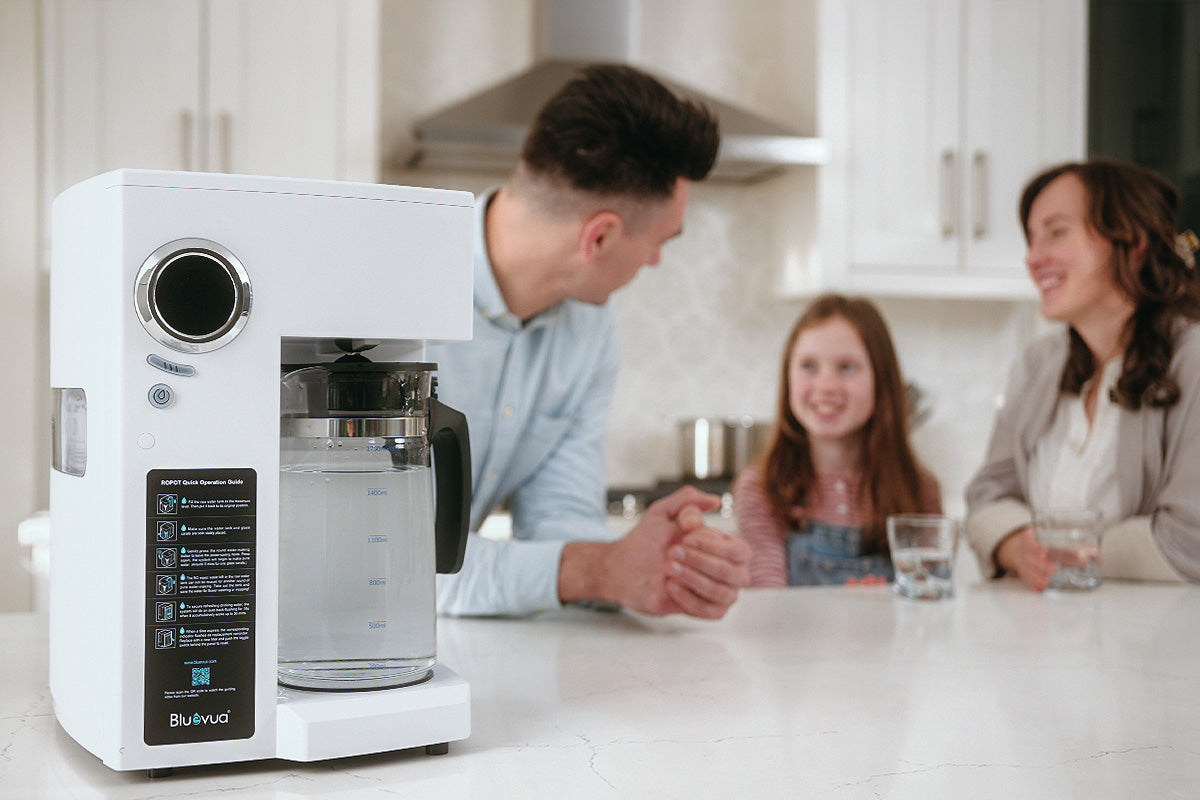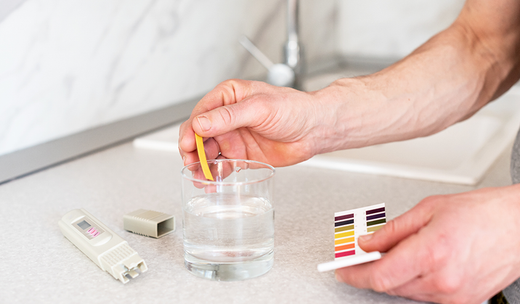Everyday life revolves around pH levels; they affect everything from the water we drink to the condition of our appliances and plants. The pH scale lets us know how acidic or alkaline different materials are: 0 (acidic) to 14 (alkaline). According to the U.S. Environmental Protection Agency, the ideal pH for drinking water is between 6.5 and 8.5, ensuring it is safe for consumption and promoting good digestive health. Furthermore, essential for the ecosystem is a balanced pH, which influences aquatic life survival and nutrient absorption in plants. This post investigates pH, why it's important, and how to properly manage it in certain settings.

What is pH?
Relating to the concentration of hydrogen ions found in a solution, pH is a scale used to indicate its acidity or alkalinity. Solutions with a pH less than 6.5 are said to be acidic; those with a pH of 7 are said to be neutral; and solutions with a pH more than 8 are said to be alkaline. The scale spans 0 to 14. This measurement clarifies the chemical character of several materials, including water.
Maintaining a neutral pH at a healthy range is absolutely vital for drinking water. It guarantees that water is neither too basic nor too acidic, so fostering ideal health by avoiding conditions as such digestive problems or discomfort. Neutral water also reduces corrosion in appliances and plumbing systems, therefore increasing their lifetime and use. Understanding and tracking pH levels helps us to make wise choices regarding the water we drink and use in our homes, therefore preserving the environment as well as our health.
Why Do Water pH Levels Matter?
pH levels directly impact aquatic ecosystems, agriculture, and human health, making it essential to understand their significance.
Human Health Considerations
For humans, consuming water with a pH that is too far from neutral (either too acidic or too basic) can pose health risks. Acidic water might corrode pipes, leading to leaching of metals such as lead and copper into drinking water. Prolonged consumption of such water can result in digestive issues and other health problems. Similarly, highly alkaline water can leave a bitter taste and potentially cause skin irritation.
For Home Aquarium
The pH level of water is vital for the survival and reproduction of aquatic organisms. Most aquatic life thrives in a narrow pH range, typically between 6.5-7.5. When water becomes too acidic or too alkaline, it can lead to harmful conditions for fish and other aquatic species. For example, a lower pH can increase the solubility of metals, which may be toxic to aquatic life, while a high pH can reduce dissolved carbon dioxide, affecting photosynthesis in aquatic plants.

For Soil and Home Garden
The clean, pH-balanced water we drink every day is not just good for us; it's also good for our plants. Soil pH affects nutrient availability and, subsequently, plant health. Most plants prefer a slightly acidic to neutral soil pH (around 6.5 to 7). If the soil is too acidic or alkaline, it can inhibit the uptake of essential nutrients such as nitrogen, phosphorus, and potassium, leading to poor plant growth and yield. Gardeners often test soil pH to adjust it through liming (to raise pH) or sulfur application (to lower pH), ensuring optimal growing conditions for their plants.
Common Effects of Water pH
- Acidic Water (< 6): Can be corrosive, leading to metal leaching from plumbing.
- Neutral Water (7): Generally safe and ideal for drinking and most uses.
- Alkaline Water (> 8): May taste bitter; often associated with hard water that can cause scaling in pipes and appliances.
In essence, ecological balance, gardening growth, and human health depend on our surroundings and daily activities keeping suitable pH levels. Frequent pH level monitoring of soil and water sources helps to reduce possible harmful effects and advance sustainability.
What is the Optimal pH Level for Water?
Water's ideal pH level will rely on its intended purpose. Different applications of water call for particular pH ranges to guarantee safety and efficacy.
1. Drinking Water
The optimal pH for drinking water is somewhat near neutral, usually between 6.5 and 8.5. This range guarantees that the water is neither excessively acidic nor too alkaline, so helping to prevent health problems and preserve a good taste. Furthermore, it prevents corrosion in plumbing systems and, therefore, lowers the potential of metal leaching into the water supply, which is neutral pH levels.

2. Plant Watering
In plant growth, the pH of watering should align with the needs of the plants being grown. Most plants thrive in slightly acidic to neutral soil conditions (around 6.5 to 7.5). Sensitive plants, such as carnivorous species, require very pure water and are highly sensitive to pH changes. Irrigation water within this pH range supports nutrient absorption, promoting healthy plant growth, and improved resistance to disease.
3. Healthy Aquatic Life
For fish tanks and aquaculture, maintaining a stable pH is crucial for the health of aquatic organisms. Freshwater fish generally prefer a pH between 6.5 and 8.0, while marine species thrive in slightly more alkaline conditions, around 8.0 to 8.5. Monitoring and adjusting pH levels help prevent stress and disease in aquatic animals.
4. Household Appliances
Water used in appliances like humidifiers and coffee machines should ideally be neutral to prevent scaling or corrosion. Hard water, often more alkaline, can cause mineral buildup in pipes and appliances, reducing efficiency and lifespan. Using purified or balanced pH water can help manage these effects.
How Do Environmental Factors and Pollutants Affect the pH of Municipal Water Supplies?
Municipal tap water is generally maintained at a neutral pH level, making it safe for drinking. However, several factors can influence its pH and quality.

Aging infrastructure poses significant risks to water quality. Old or corroded pipes can alter water's pH by leaching metals like lead and copper into the supply, potentially introducing harmful substances. This secondary contamination highlights the need for effective water purification systems to ensure clean and pH-balanced drinking water.
The pH of tap water can vary due to differences in natural environments, water sources, and treatment processes. These variations are influenced by local geological conditions and municipal water treatment practices designed to address specific regional challenges.
Pollution significantly impacts water pH levels. Industrial emissions and vehicle exhaust release sulfur dioxide and nitrogen oxides, which contribute to acid rain formation. Acid rain lowers the pH of soil and water bodies. Acid rain, with its pH typically ranging from 4.0 to 5.5, poses significant risks to municipal water supply systems by promoting corrosion and contaminating water sources. Such acidic conditions can cause damaging metal leaching within water systems.
Industrial spills and other sudden pollution events can contaminate water supplies, change their pH, and raise toxicity hazards. These events need quick response and treatment to stop long-term consequences for health.
To guarantee safe drinking water despite these environmental challenges, municipalities have to keep an eye on water quality, modernize infrastructure, and apply efficient treatment procedures.

How to Obtain Healthy Drinking Water with Optimal pH Levels
In the face of fluctuating pH levels and potential contaminants in municipal water supplies, Reverse Osmosis (RO) water purifiers offer an efficient and reliable solution. These systems are designed to remove virtually all impurities you don't want from water, including heavy metals, microorganisms, chlorine, and pesticide residues, ensuring you receive pure drinking water regardless of the pH variations in the municipal supply.
Benefits of RO Purifiers
- Effective Filtration for Elevated Water Quality: RO systems use a 0.0001μm semi-permeable membrane that effectively filters out contaminants, providing cleaner and safer water than standard tap solutions. They are particularly useful in areas where water quality is inconsistent or compromised by pollution.
- Re-mineralization for Balanced pH and Enhanced Taste: Many modern RO systems come with re-mineralization filters. After removing impurities, these filters add minerals such as calcium and magnesium back into the water, neutralizing the pH levels to around 7.5. This not only improves taste but also helps adjust the water's pH to a more balanced level, promoting overall health benefits.
- Consistent Quality, No Matter the Source: By using an RO purifier, you can be confident that your drinking water remains safe, clean, and at an optimal pH level, no matter the initial condition of your municipal supply.

Investing in an RO water purifier guarantees access to premium drinking water that supports both safety and health, thereby making it a wise decision for homes worried about possible pollutants and water quality fluctuations.





ทิ้งข้อความไว้
ความคิดเห็นทั้งหมดจะได้รับการตรวจสอบก่อนที่จะเผยแพร่
เว็บไซต์นี้ได้รับการคุ้มครองโดย hCaptcha และมีการนำนโยบายความเป็นส่วนตัวของ hCaptcha และข้อกำหนดในการใช้บริการมาใช้